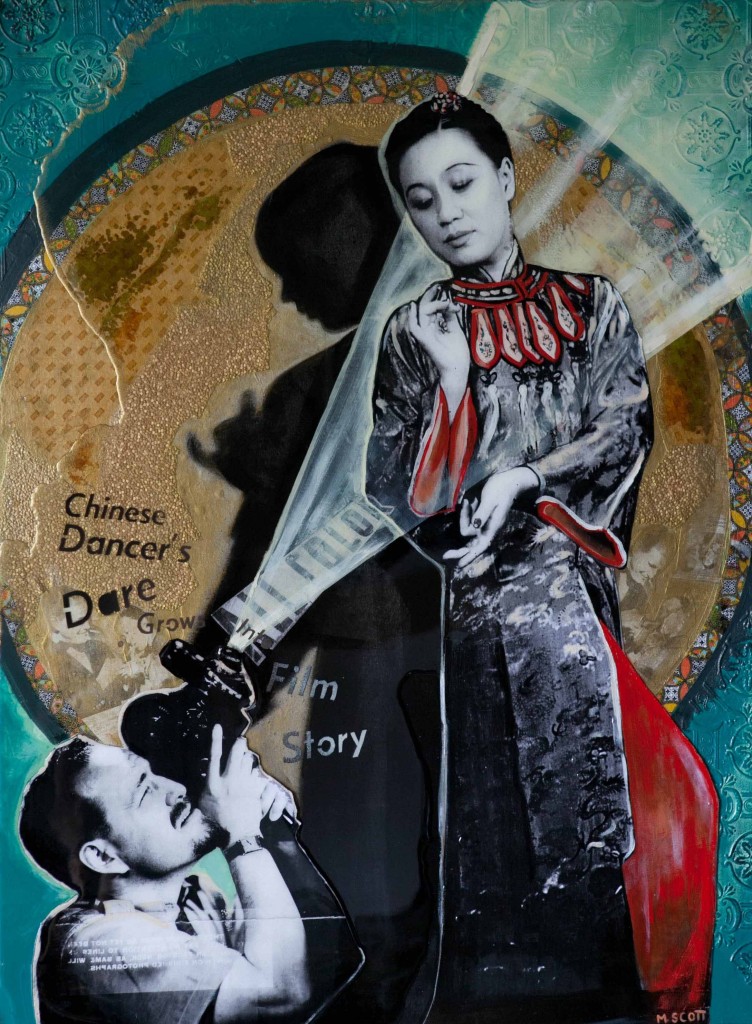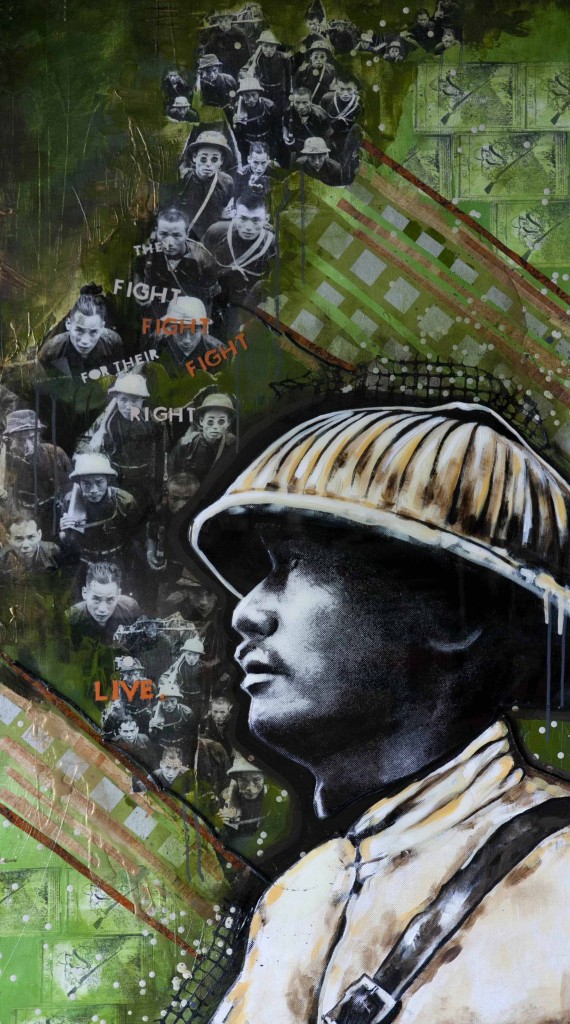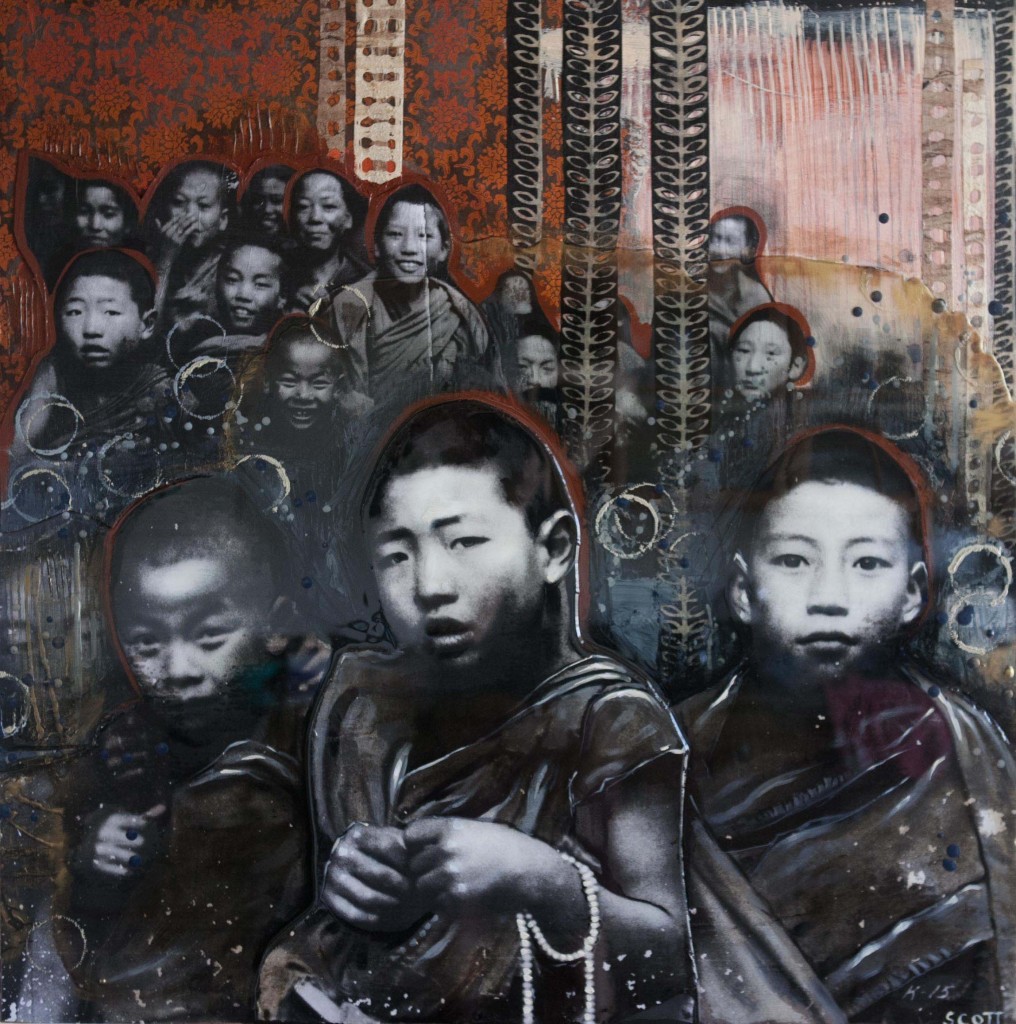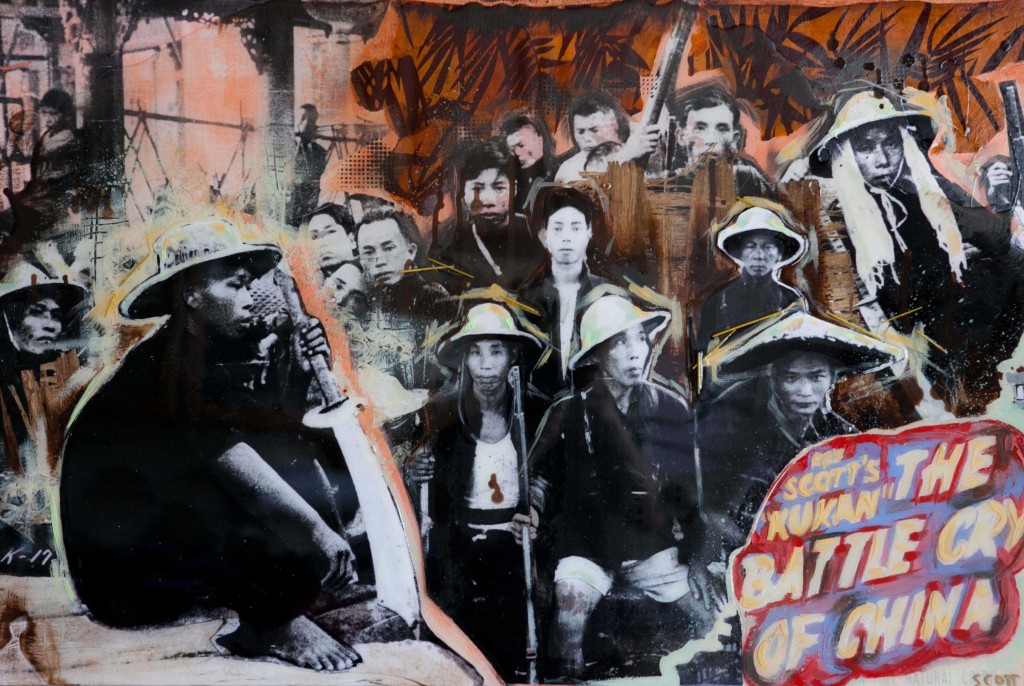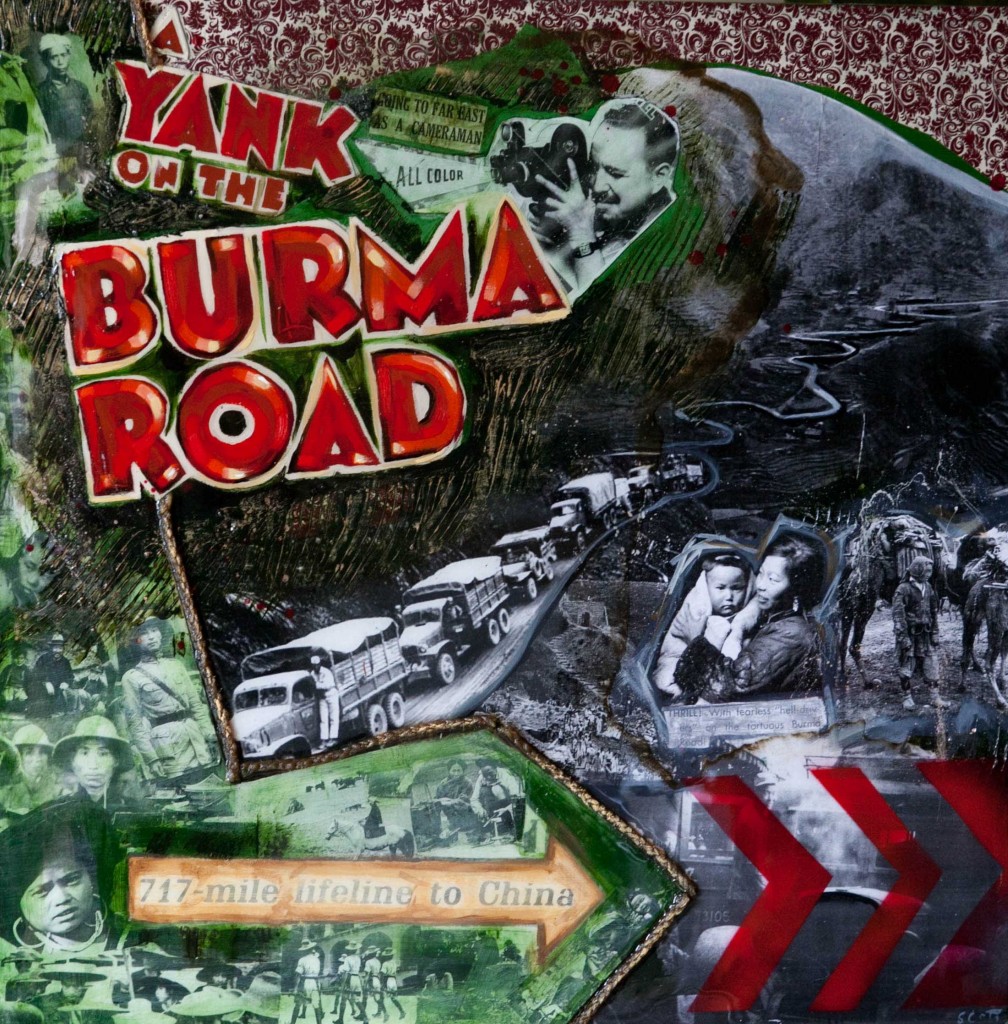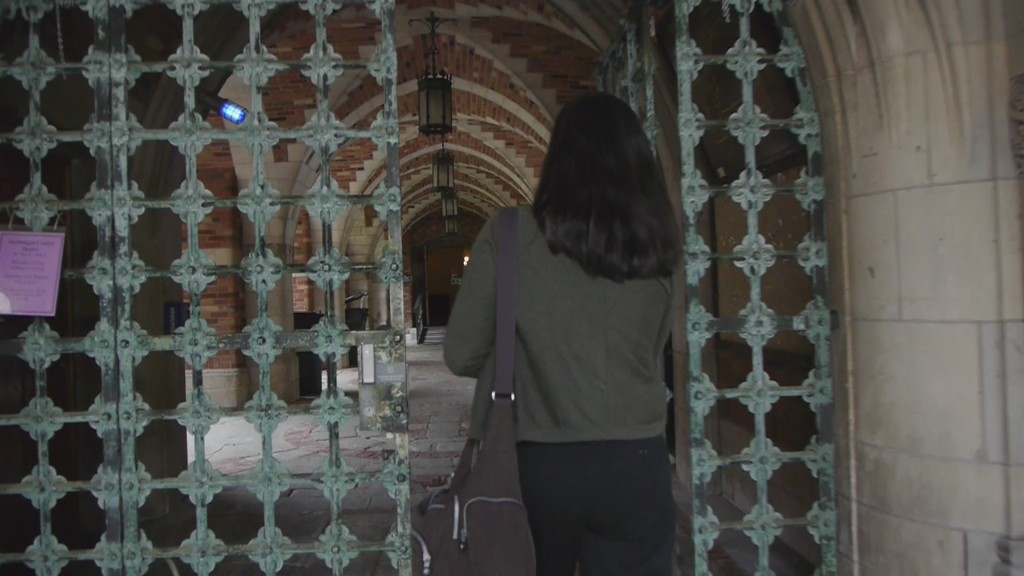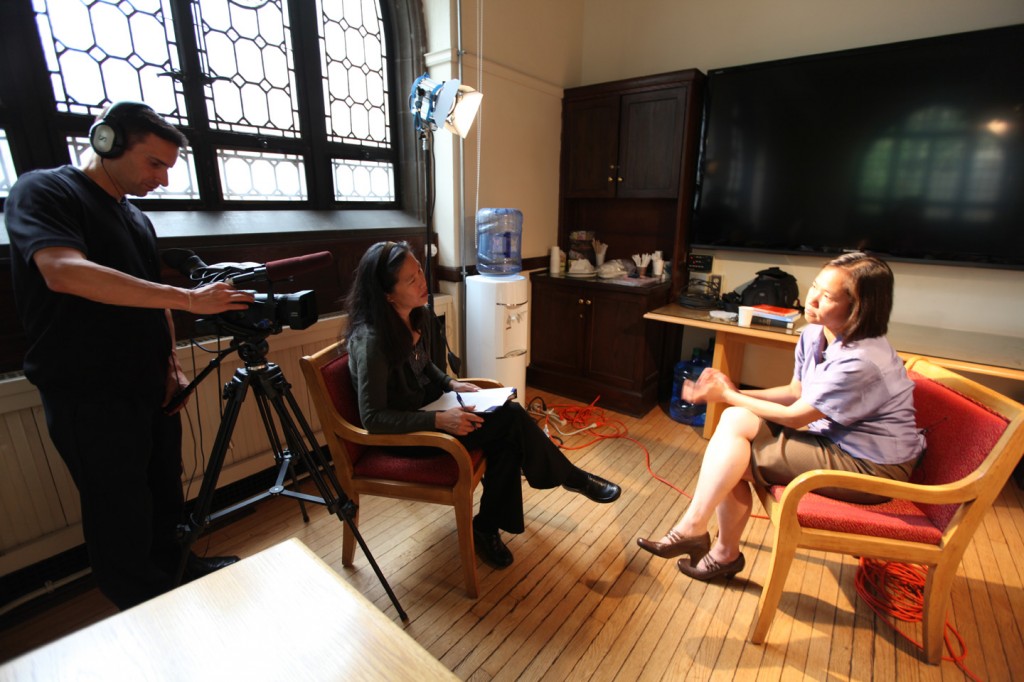Upcoming Screenings:
no event
Follow us on Facebook
HELP BRING FINDING KUKAN TO CLASSROOMS
Sign up for our mailing list.
Category Archives: Road Trips
November 29, 2014 — Year in Review (Part 2 — New York in June)
New York in June could only be made possible by the hospitality of longtime friend Peer Just. A free place to stay in New York meant that I could funnel some of our funds towards filming two crucial interviews with Asian American scholar Judy Wu and the award-winning author Danke Li. Both provided important insights into Li Ling-Ai’s motivations and how World War II transformed the everyday lives of women in both the United States and China. Answering the last-minute call for camera help were our New York go-to DP Frank Ayala and another longtime friend Ruth Bonomo.
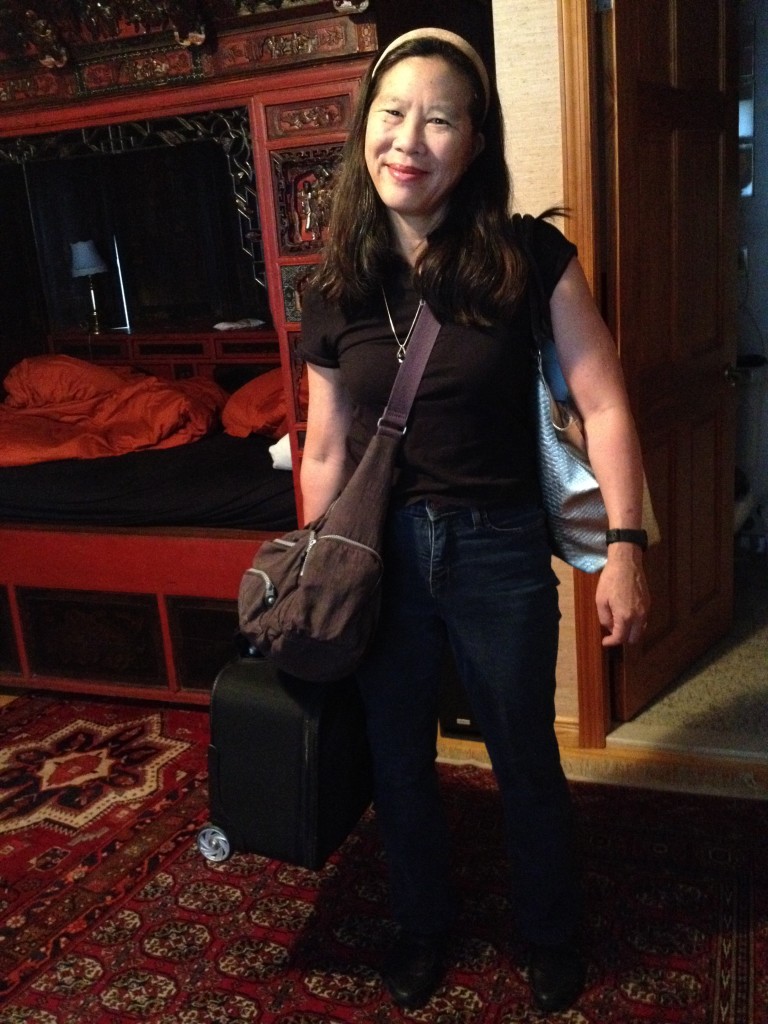
Leaving NYC home base for a day of production on Long Island — first the subway, then the train, then the ferry.
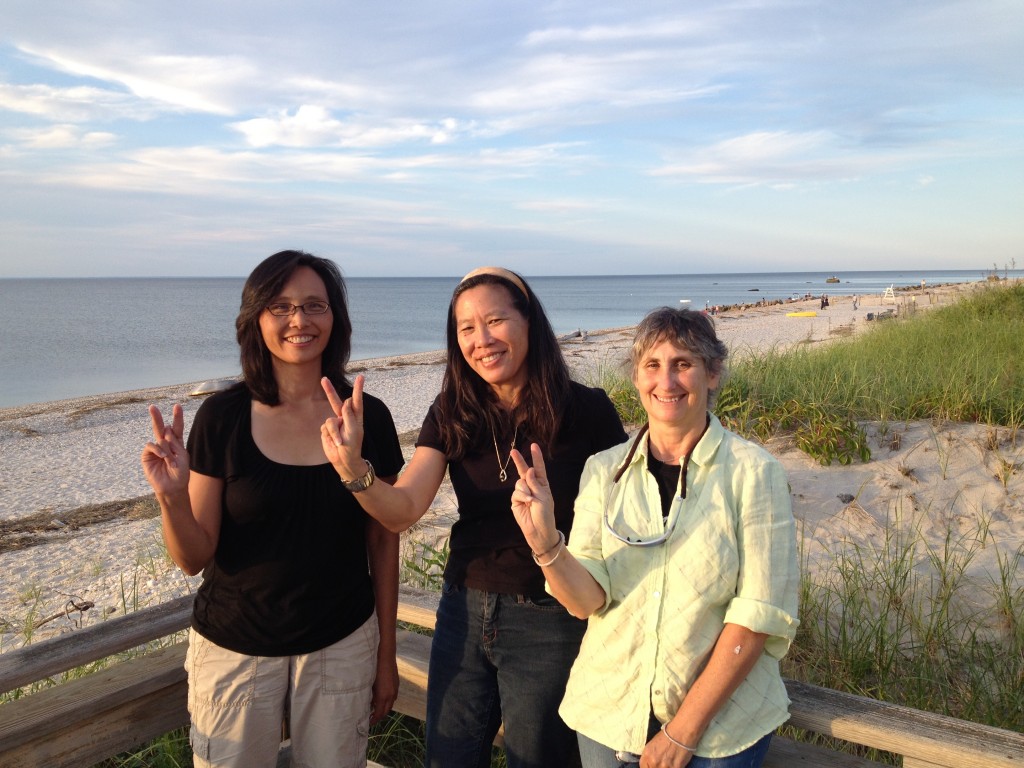
Judy Wu, author of DR. MOM CHUNG, took time out from her Port Jefferson vacation to sit for a great interview. Ruth Bonomo pitched in as DP on short notice, providing wheels, camera and lights. Judy’s family fed us a great spaghetti dinner beachside. Signing K for KUKAN!
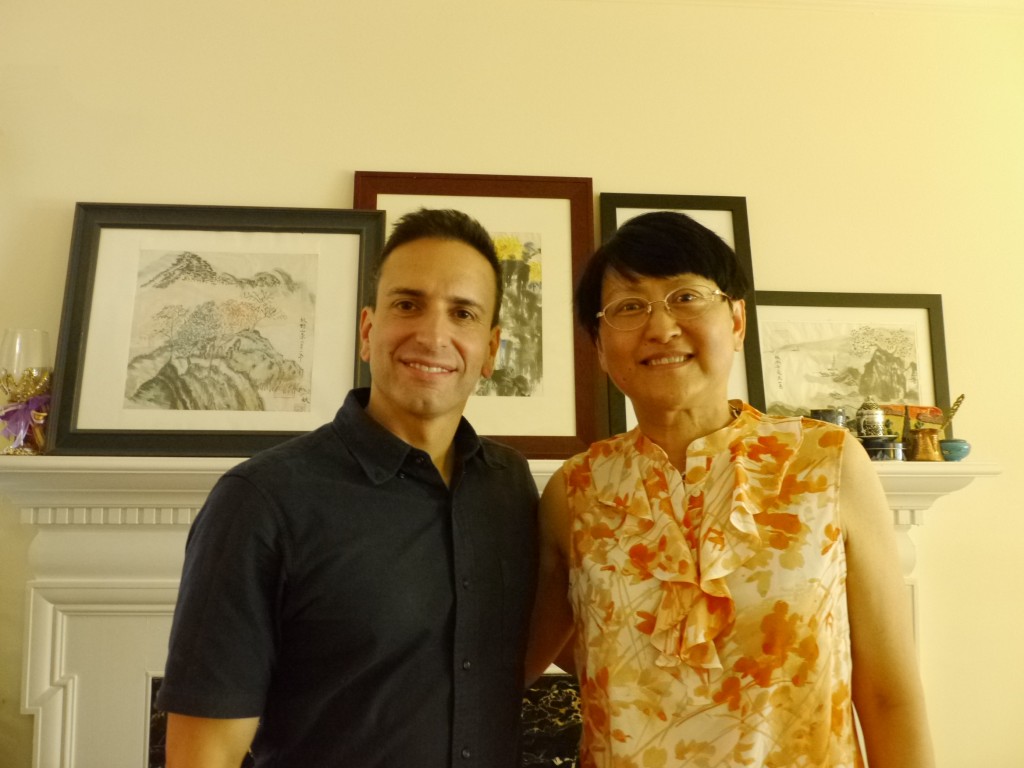
DP Frank Ayala with Danke Li, author of ECHOES OF CHONGQING, WOMEN IN WARTIME CHINA
A visit to New York also meant I got to hang out with Calamity Chang, who has volunteered to record temporary voice over lines that allow us to edit our historical scenes. Calamity constantly inspires me by her willingness to embrace her performance instincts and bare it all in her wonderfully tongue-in-cheek burlesque shows. She also knows her Chinese history and promotes projects like ours that bring it to the forefront. Her musician/photographer husband Mike Webb put in hours of free time as our sound man while dog Chewie quietly put up with our intrusion. After a super long recording session on a sunny Sunday afternoon, we all needed a New York specialty cocktail.

Going over scripts with Calamity Chang.

Musician and Photographer Mike Webb pitches in as sound man to record our temporary voice over tracks.

Chewie after a long recording session

One of the killer cocktails I had in NYC featuring cucumber and gin
Just being in NYC is a real shot in the arm for a filmmaker. Visual stimulation is everywhere and so are other artists whose very existence and work are like cheers from the sidelines.

Inspiration from Steven Salmieri and his wife Sydney Michelle

Inspiration from artist, hat designer and jewelry maker Carol Markel

Inspiration from my husband Paul Levitt who is designing a book with Dana Martin about his visit with Man Ray

More inspiration from a screening and Q&A with D.A. Pennebaker and Chris Hegedus
Before my New York trip I got word that I received a fellowship to go to China to join a group of high school educators form Canada and New Jersey on a World War II centered study tour. It would be my first trip there, so China was on my mind.

Looking ahead to China in July at the Ai Wei Wei exhibit in Brooklyn

Imagining China

China Kitsch
Li Ling-Ai’s spirit is also close at hand when I am in NYC. Her great friend Larry Wilson offered to point out the third floor apartment where she spent most of her life on West 55th street. The breeze picked up and the trees outside the apartment did a dance as we looked up to the third floor.

October 3, 2012 — Michelle Scott Delivers a Knock Out with her KUKAN SERIES
When I first made contact with Rey Scott’s granddaughter Michelle Scott and filled her in a little about the story behind KUKAN, she felt a need to transfer that story into paint and shared with me a vision she had for creating a whole room of paintings dedicated to her grandfather and KUKAN. It seemed like a far-fetched dream back then. So I was more than a little excited to go to Atlanta to witness the opening of Michelle’s solo show — THE KUKAN SERIES. Michelle hadn’t shared any images of the new work with me, so I wasn’t prepared for the visual sweep and emotional power of the work. It literally brought me to tears. Here are a few choice pieces from the show. WARNING — these photos do not do the pieces justice. The real pieces have an almost three-dimensional quality that allows the viewer to enter into the scene and experience a little of Rey Scott and Li Ling-Ai’s world back in the late 30’s.

Artist Michelle Scott with “Start of a Journey” the exclusive premium available for a $5,000 Kickstarter pledge (partially tax deductible).
The 36“X36” piece that Michelle created exclusively for our Kickstarter fundraising drive is displayed right in the front window of 2Rules Fine Art in Marietta. Casual strollers walking down the sidewalk can’t help but be pulled in to find out with the imagery is all about. For close up details of this painting go to our Kickstarter home page.
The KUKAN Series contains a few gorgeous tributes to Li Ling-Ai the Chinese American author who was the uncredited co-producer of KUKAN with Rey Scott.
The work below contains images of Li Ling-Ai from three different decades and three different locations (the old Honolulu Academy of Art, Beijing China, and New York City)
There are also fabulous pieces that provide a visual montage of the China witnessed through Rey Scott’s camera. He took both stills and 16mm color movies. Some of his old cameras are on display too with the original stills.
Rey Scott traveled all the way to Tibet and filmed some of the first color footage of prayer rituals there.
Michelle’s take on the original KUKAN lobby cards for the United Artists version of the film.
Rey Scott also filmed the famous Burma Road as it was being built.
A reminder of the British influence in Hong Kong which fell to the Japanese in 1941.
A whole movie could be made just about the baby giant panda bear that Rey Scott brought from Chengtu to the Chicago Zoo. Originally christened “Li Ling-Ai” by the foreing journalists in Chungking, it was later named Mei Lan when it was identified as a boy panda bear.

“Portrait of a Lady” and “For Him” are the first two pieces that Michelle Scott made in the KUKAN Series
There are many more gems in this show. But the emotional highlight for me was being able to see the first two portraits of Rey Scott and Li Ling-Ai that Michelle did. I first saw them on her website before we even knew each other and before she even knew who Ling-Ai was. This was the first time I was able to see them both in person. Since the pieces had been sold to different collectors several years ago, this was also the first time they were reunited in the same room for quite some time — a symbol of hope for me as I continue to seek funding to finish FINDING KUKAN.
If you are in the Atlanta area make an effort to see this historic show — up only until October 26, 2012
July 24, 2012 — An Earfull At the Ear Inn
As the weeks wear on and I get closer to the deadline for submitting a grant application to the NEA, I have periods of doubt and wonder if it’s even worth it to try for such a prestigious thing. And if I don’t get awarded a grant what will it mean – that the project is unworthy, and I should give up?
Glancing through pictures I took in May I’m reminded that getting grants and making Art are two different things. These black and white snaps were taken on a hot summer night when I joined my husband Paul and our friend Peer at one of NY’s oldest bars – The Ear Inn on Spring Street.
As I ate muscles at the bar and listened to old-time jazz, a woman named Katerina introduced herself. She had an intriguing accent and was very charming.
Several minutes later her friend Roland joined her – an artist, he showed her photos of his latest work on his Iphone.The striking shadows in his imagery prompted me to talk about the ideas for shadow play I had in mind for FINDING KUKAN.
For some great use of shadows, you should see THE THIRD MAN, said Roland. He sounded like he knew what he was talking about. When I got home I looked up Roland’s website – photos of his performance pieces made me think of all the possibilities before me. The doors to creation opened up a crack.
As I watched THE THIRD MAN for the first time the doors were thrown wide open. Every shot was a compositional gem and fired up ideas in my head for ways to visualize my own search.
I’m hanging on to the DVD so I can watch it for the third time – a reward I’m going to give myself after getting that grant app finished. You DO need a lot of money to make movies, but you DON’T need a lot to enjoy the heck out of them.
Thanks to Roland Gebhardt and the Ear Inn for reminding me of why I’m writing grants applications in the first place.
Whether it’s the bar, the gym, or the beach, we all need to leave the desk once in awhile to get a fresh perspective. Where do you go when you need a creative breath of fresh air?
June 28, 2012 — A Visit to Yale and Chinese Exclusion
The recent FINDING KUKAN shoot at Yale University brought out the perpetual student in me. You can’t help but be awed by the vaulted ceilings and Knights of the Round Table atmosphere of the Hall of Graduate Studies where my interview with Yale Professor of American Studies Mary Lui took place.
The building reminds you how much history has come before you and how much you are ignorant of.
Fortunately the halls of learning at Yale are populated by people like Mary who dedicate their lives to gathering knowledge and disseminating it to people like me.
In trying to understand the social climate that prompted Li Ling-Ai and Rey Scott to risk money and life to make KUKAN, Mary Lui reminded me that the behavior of Chinese Americans like Li Ling-Ai was still governed in part by prejudicial immigration laws enacted against the Chinese — the most infamous one being the Chinese Exclusion Act passed in 1882.
Meant to keep cheap labor from entering the US, the exclusion laws ended up doing much more than that. From restricting the formation of Chinese families, to rendering the few Chinese women around at the time exotic creatures with questionable backgrounds the Exclusion Laws had negative repercussions on even the richest and most educated Chinese Americans. It’s no wonder that with so few Chinese Americans around that stereotypes and misconceptions about them would form.
I came back to Hawaii much better prepared to appreciate the historic bill recently passed by Congress to officially apologize for the prejudicial laws that targeted Chinese and other Asians in America for over 80 years.
One of the stereotypes I had about my own ethnic background was that Chinese don’t make waves and passively accept their fate, letting bygones be bygones.
The courageous efforts of people like Congresswoman Judy Chu and organizations like the 1882 Project belie that stereotype and bring a new validation to the history of Asians in America that will hopefully prompt more stories about an era of exclusion that we still don’t know enough about.
Are there ways that exclusion laws have affected your life? Let us hear from you.
December 5–10, 2011 — LA Production Shoot
My main reason for traveling to LA was to interview Li Ling-Ai’s nephew Andrew Li who was a young boy of 8, living in Nanking when Rey Scott and Li Ling-Ai began pre-production for KUKAN.
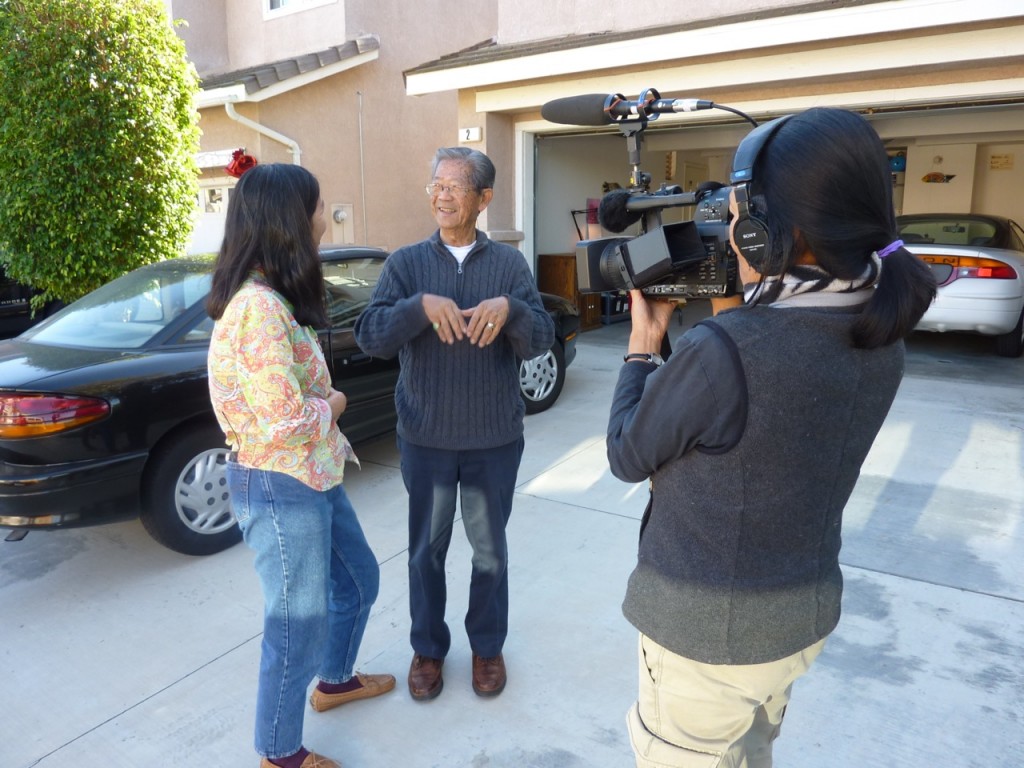
Ann Kaneko films FINDING KUKAN director Robin Lung meeting with Li Ling-Ai’s nephew Andrew Li.
I hoped to find out more information from Andrew about Ling-Ai’s connections in China at the time. Though I was able to gather some valuable information from my interview, the 5 days in LA turned out to be about so much more — a lot of it behind the scenes stuff that will never make it into the documentary.
Getting to know the talented filmmaker Ann Kaneko was one of the unexpected bonuses of the trip. Thanks to generous donations from early FINDING KUKAN supporters, I was able to hire Ann for a couple of days as my LA Director of Photography. Having a dp with a real interest in the project and experience with both editing and being a character in her own films was invaluable.
Witnessing Ann balancing her dedication to her work with the demands of raising her 8‑month old daughter Ceiba was a real inspirational shot-in-the-arm too.
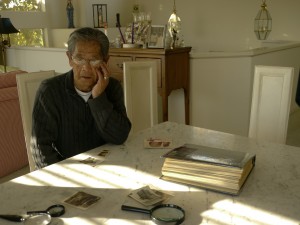
Andrew Li inspects photographs
As I lunched with Andrew Li, his daughters Portia and Quincy, and his wife Gilda I got a sense of the rich life Li Ling-Ai had beyond KUKAN and the profound ripple effect that personal stories can have through time and space.
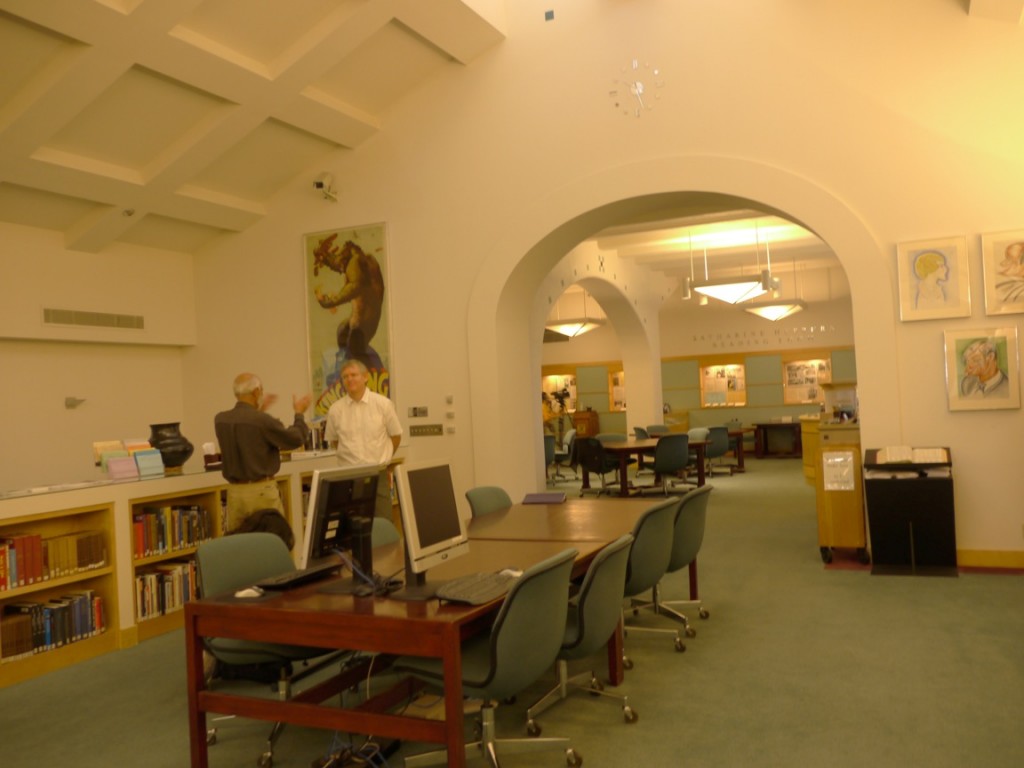
John Zainer talks to Ed Carter in front of the $500,000 King Kong poster that decorates the Margaret Herrick Library’s reading room.
Filming B‑roll scenes of Ed Carter at the Margaret Herrick Library introduced me to this gorgeous building and amazing film history resource for the first time (I am already thinking of excuses to return to spend more leisurely hours there).

Ann Kaneko and Rebecca Bozzo prep for a shoot at the Margaret Herrick Library
It also gave me an excuse to hook up with the perennially upbeat Rebecca Bozzo again. Becca is a dedicated young filmmaker who shares a passion for old movies and has been a FINDING KUKAN supporter from almost day one.

Dan & Denise Levenick with Robin Lung
Dan & Denise Levenick invited me to their home in Pasadena to view their mother’s home movies and photographs of 1930s Hawaii. Besides giving me another reason to marvel at the generosity and kindness of strangers, Dan and Denise provided me with precious “before-my-time” knowledge of my home town.
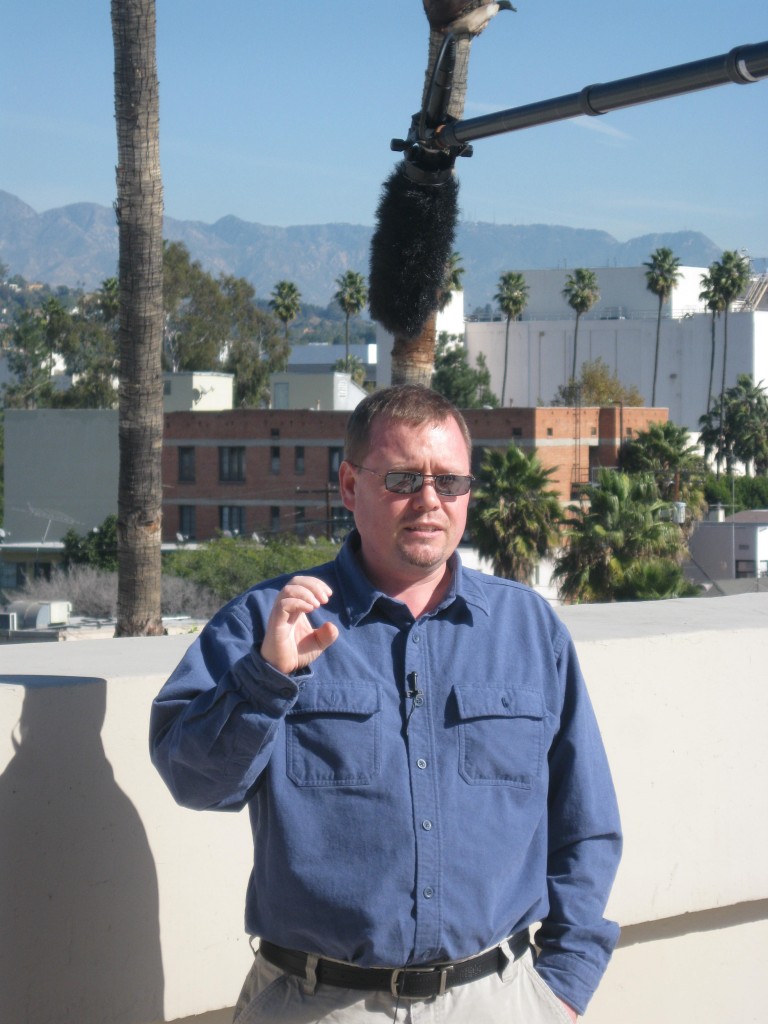
AMPAS Preservationist Joe Lindner describes how curled the KUKAN film print is.
Talking to AMPAS Presrevationist Joe Lindner about the arduous process of restoring KUKAN gave me new insights into the precious nature of old film, the historic value that even old home movies have, and the galling number of films that have been destroyed by time.

Ille-Heid Zainer and her fresh baked bread.

John Zainer’s 1971 VW Van was the perfect LA production vehicle.
Finally my hosts in LA, John and Ille-Heid Zaner, provided me with an intimate view of what living in LA can be like, inviting me to neighborhood parties, providing home-cooked meals after long days of shooting, chauffering me around in vintage vehicles, and sharing Ille’s sister Elke’s amazing Christmas cookies with me.

Elke’s Cookies
The result is that after my 5‑day production shoot in LA, a city that I once had a very low opinion of, I can’t wait to go back.
July 23, 2011 — A Visit to the New York City Office of the National Archives
When I first started checking to see if Li Ling-Ai could have been the real life inspiration for the fictional detective Lily Wu, I tracked down some of her travels through boat records that are available on Ancestry.com. One of the Ancestry records was a New York Exclusion file that listed the date of her arrival in San Francisco. Going over the notes on the record again, I saw that Li Ling-Ai’s file included an interrogation. Since the interrogation occurred only a year before Li Ling-Ai met Rey Scott and conceived of making the movie KUKAN, I was anxious to read through the interrogation to see if it contained any clues. In July I finally got a chance to visit the NYC office of the National Archives where Li Ling-Ai’s Exclusion file is located.

Robin Lung examines Li Ling-Ai’s Chinese Exclusion File at the NYC office of the National Archives
It was amazingly well-preserved, and I had a lot of mixed emotions while examining it. On the one hand, I was excited to see a photograph of Li Ling-Ai in the file that I had never seen before and letters that were hand-written by her. Handling the documents gave me a very visceral connection to the past and to this woman that I have been pursuing for the last couple of years.

Li Ling-Ai’s Chinese Exclusion File
On the other hand I was appalled that this file existed in the first place. I had to think about the blatant anti-Chinese discrimination that led to The Chinese Exclusion Law — the reason for the creation of the file I was touching. I was astounded that a U.S. citizen like Li Ling-Ai (she was born in Hawai‘i in 1908 when it was already a U.S. Territory) who had a U.S. Passport (documented in the file) would have to spend days at the NYC Immigration Office in order to get a re-entry form that would make it possible for her to come back to her own country after leaving it! And that she would have to sit through an interrogation to prove that she was authentic despite all the other documentation she had made me even more indignant.
As a researcher, I was thankful to be able to access the revealing information in the file and draw both the positive and negative energy from it. So I have to acknowledge the hard work that goes into indexing, storing and retrieving these records. That day at the Archives I witnessed two volunteers who were laboriously going through files and entering data into laptops so that others like me could find information about ancestors and characters from the past. I wish I had gotten their names and taken photos of them if only to pay a small homage to all the others like them who have helped forward my investigation.

Documents in Li Ling-Ai’s Chinese Exclusion File
July 11–16 Road Trip to Kennesaw & Tallahassee

Director Robin Lung films in Georgia

Michelle Scott with a few paintings from her KUKAN series
As I packed my suitcase I worried that since Michelle and I didn’t really know each other the trip could be a total fiasco. Fortunately Michelle and the rest of the Scott family were so openhearted and supportive that I felt instantly comfortable after meeting them and the trip was more successful than I could have imagined. Witnessing Michelle’s passion for her art and her commitment to preserving her grandfather’s legacy infused me with new energy to face all of the tedious things that go along with documentary filmmaking (like logging and transcribing footage and writing grant proposals).
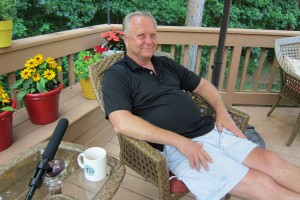
Ray Scott relaxes before interview.
I realize that gaining access to people and places outside of my everyday comfort zone is one of the immeasurable rewards of this process. I’m looking forward to what the next road trip will bring me.
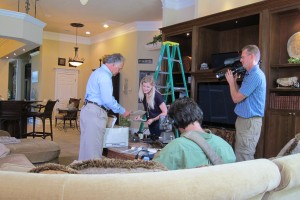
Mark Scott and Michelle Scott examine Rey Scott’s cameras as cameraman Kevin Deyo films the scene.


